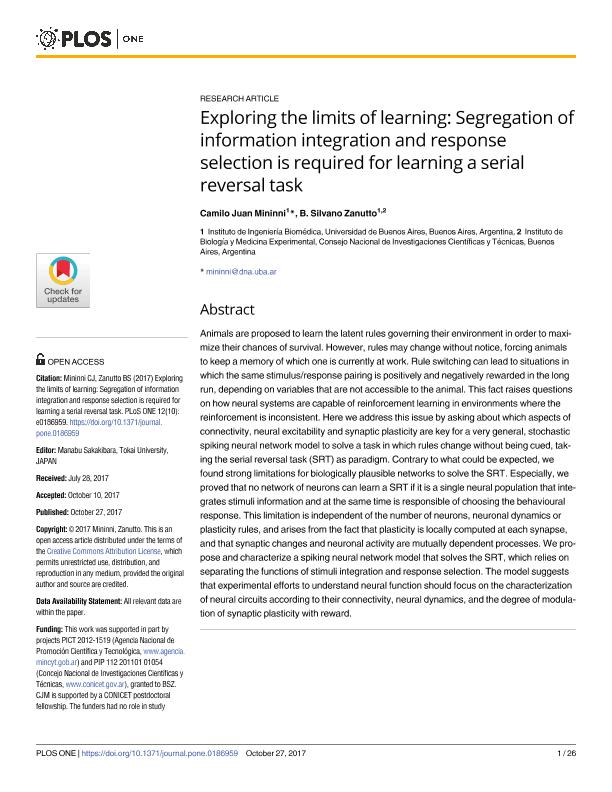Mostrar el registro sencillo del ítem
dc.contributor.author
Mininni, Camilo Juan

dc.contributor.author
Zanutto, Bonifacio Silvano

dc.date.available
2018-04-06T20:16:21Z
dc.date.issued
2017-10
dc.identifier.citation
Mininni, Camilo Juan; Zanutto, Bonifacio Silvano; Exploring the limits of learning: Segregation of information integration and response selection is required for learning a serial reversal task; Public Library of Science; Plos One; 12; 10; 10-2017; 1-26; e0186959
dc.identifier.uri
http://hdl.handle.net/11336/41255
dc.description.abstract
Animals are proposed to learn the latent rules governing their environment in order to maximize their chances of survival. However, rules may change without notice, forcing animals to keep a memory of which one is currently at work. Rule switching can lead to situations in which the same stimulus/response pairing is positively and negatively rewarded in the long run, depending on variables that are not accessible to the animal. This fact raises questions on how neural systems are capable of reinforcement learning in environments where the reinforcement is inconsistent. Here we address this issue by asking about which aspects of connectivity, neural excitability and synaptic plasticity are key for a very general, stochastic spiking neural network model to solve a task in which rules change without being cued, taking the serial reversal task (SRT) as paradigm. Contrary to what could be expected, we found strong limitations for biologically plausible networks to solve the SRT. Especially, we proved that no network of neurons can learn a SRT if it is a single neural population that integrates stimuli information and at the same time is responsible of choosing the behavioural response. This limitation is independent of the number of neurons, neuronal dynamics or plasticity rules, and arises from the fact that plasticity is locally computed at each synapse, and that synaptic changes and neuronal activity are mutually dependent processes. We propose and characterize a spiking neural network model that solves the SRT, which relies on separating the functions of stimuli integration and response selection. The model suggests that experimental efforts to understand neural function should focus on the characterization of neural circuits according to their connectivity, neural dynamics, and the degree of modulation of synaptic plasticity with reward.
dc.format
application/pdf
dc.language.iso
eng
dc.publisher
Public Library of Science

dc.rights
info:eu-repo/semantics/openAccess
dc.rights.uri
https://creativecommons.org/licenses/by-nc-sa/2.5/ar/
dc.subject
Serial Reversal Learning
dc.subject
Stability-Plastisity Dilemma
dc.subject
Neural Network Models
dc.subject
Theoretical Neuroscience
dc.subject.classification
Otras Ciencias Biológicas

dc.subject.classification
Ciencias Biológicas

dc.subject.classification
CIENCIAS NATURALES Y EXACTAS

dc.title
Exploring the limits of learning: Segregation of information integration and response selection is required for learning a serial reversal task
dc.type
info:eu-repo/semantics/article
dc.type
info:ar-repo/semantics/artículo
dc.type
info:eu-repo/semantics/publishedVersion
dc.date.updated
2018-04-06T13:53:24Z
dc.identifier.eissn
1932-6203
dc.journal.volume
12
dc.journal.number
10
dc.journal.pagination
1-26; e0186959
dc.journal.pais
Estados Unidos

dc.journal.ciudad
San Francisco
dc.description.fil
Fil: Mininni, Camilo Juan. Universidad de Buenos Aires. Facultad de Ingenieria. Instituto de Ingeniería Biomédica; Argentina. Consejo Nacional de Investigaciones Científicas y Técnicas; Argentina
dc.description.fil
Fil: Zanutto, Bonifacio Silvano. Consejo Nacional de Investigaciones Científicas y Técnicas. Instituto de Biología y Medicina Experimental. Fundación de Instituto de Biología y Medicina Experimental. Instituto de Biología y Medicina Experimental; Argentina. Universidad de Buenos Aires. Facultad de Ingenieria. Instituto de Ingeniería Biomédica; Argentina
dc.journal.title
Plos One

dc.relation.alternativeid
info:eu-repo/semantics/altIdentifier/doi/http://dx.doi.org/10.1371/journal.pone.0186959
dc.relation.alternativeid
info:eu-repo/semantics/altIdentifier/url/http://journals.plos.org/plosone/article?id=10.1371/journal.pone.0186959
Archivos asociados
